Naval Missiles – SAM, SSM, ASW, Airborne, Sub.
⚙ From the origins to these days: Naval Missiles
Very old attemps: Ancient rocketry
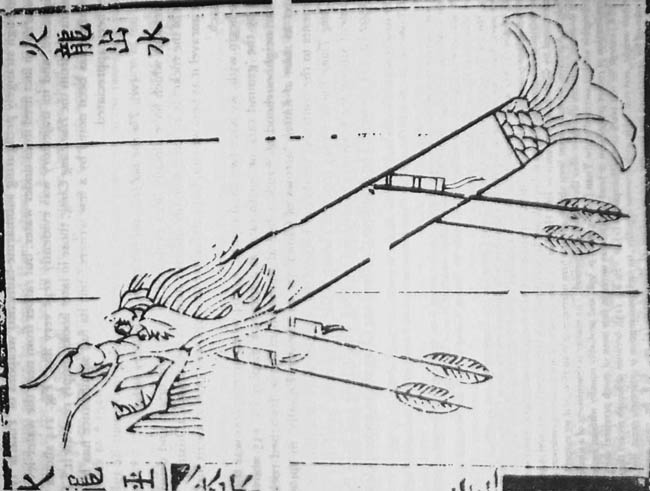
Illustration of the Huolongchushui, 14th century Chinese military treatise Huolongjing by Jiao Yu and Liu Bowen (Ming dynasty).
But well before that, there were ancient Chinese descriptions of such a “missile”, which were very large unguided rockets. This was the Huolongchushui, (“fire dragon issuing from the water”) 火龙出水, a very early multistage rocket and ballistic missile of post-classical China. Not really offensive as it had no warhead, but more to strike fear into enemy troops. It had a magazine of three rocket driven arrows, located within the mouth of the missile and thus was the world’s first “multistage rocket” used in naval battles. It had a hollow bamboo tube with a carved wooden dragon head and tail and was about five feet long (1.50 m). Both the forward and tail sections contained four rockets, packed with gunpowder for propulsion. The main idea was the long-burn fuses facing downwards from the forward rockets were ignited by the fuses of the rockets inside which shoot out those of its mouth. So the Huolongchushui itself was also a rocket carrier.
Ancient rocketry was used in the 14th-16th centuries by Asian powers, notably China and Korea, especially the latter.
Early missiles of WWI
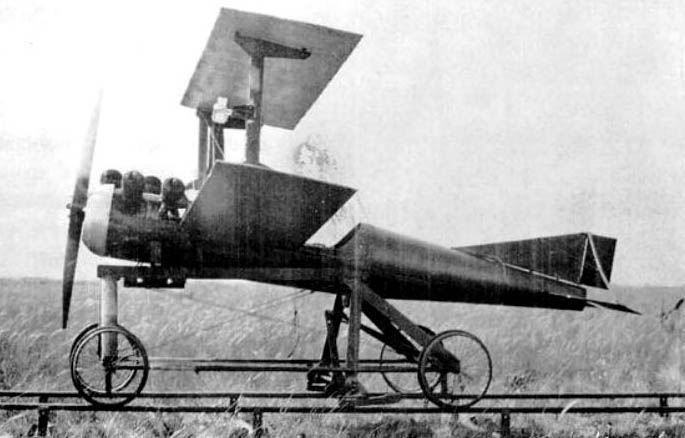
The earliest recent attempt of a naval missile was a guided midsile, was the Liberty Eagle, made by Wright in 1918, designed by Orville and Fred Nash. It was a small unmanned biplane from the Dayton Wright Airplane Company called Liberty Eagle and nicknamed “the Bug” designed as a guided missile, using a gyroscopic stabilizer, and the first attempt ever. Several were built and tested in Pensacola, Florida, half damaging their target. src: flyingmachines.ru.
Guided missiles off WW2
German antiship Missiles
Henschel
US Missiles
The trauma of Kamikaze attacks at the end of WW2 conducted the navy to a trusted AA defense against hostile aircraft, with better chances of eliminating the target than peppering rounds around. There was already a solution, pioneered by the Germans in WW2, although they were intermediate between future antiship missiles and guided bombs. Operation Bumblebee launched by the Navy help testing US Navy ramjet missiles in 1945, and the Applied Physics Lab PTV-N-4 Cobra/BTV first flew in October 1945. The program went on and eventually reached its critical point, the RIM-8 Talos missile.
The “Three T” (Talos, Terrier, and Tartar) were really at the base of the US Navy missile program in the 1950s. They were working in conjunction with the Navy’s carrier-based fighters, and point-defense systems. The most impressive one was the Talos, the “big one”, for long range interception, high altitude. This was the “soviet bomber killer”. At some point in its development it was defined as a universal missile. Its operational requirements were daunting, ever higher, faster, to be effective against equally capable targets. It became larger with a booster, at four tons. Therefore to cover the less demanding medium range, the Navy developed the smaller Terrier and Tartar.
RIM-8 TALOS
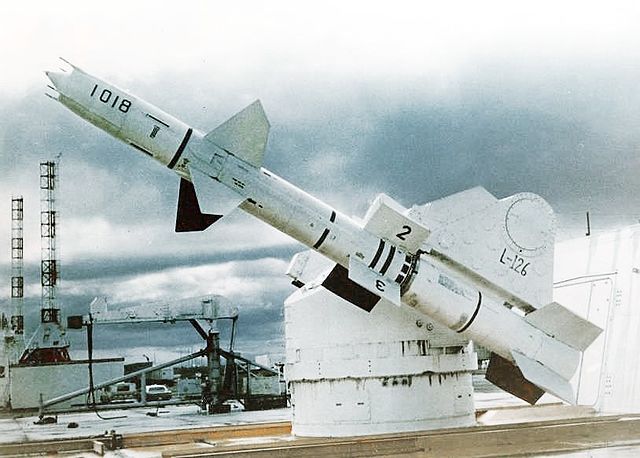
RIM-8 talos and launcher; This was the standard long range, high altitude missile, with a ramjet and a rod-based warhead.
The RIM-8 Talos was first used on the freshly converted USS Galveston in 1958, operational in early 1959. The Talos homed in on the target semi-actively and as the development went one and upgrades allowed its final figures of 2.5 Mach, 100 nautical miles, 80,000 feet of ceiling. If fighters with long range air-to-air missiles failed, Talos was the last recourse.
To eliminate its target, the Talos used a continuous-rod warhead: Rods were wrapped around an explosive charge, which forced them apart when detonating, forming an expanding metal circle that could cut through the airframe and fuselage at great velocity.
It was costly, but the most capable first-generation SAM in the navy, but required a large dedicated space to operate, so a heavy cruiser hull was ideal. However to make it more common, the Navy pressed the development of the cheaper Terrier and Tartar to be used on smaller cruisers and destroyers, and deployed missiles at a larger scale, and quicker. During the Vietnam war, Talos claimed three MiGs and it remained in the inventory for long, converted into supersonic Vandal target drones.
RIM-2 TERRIER
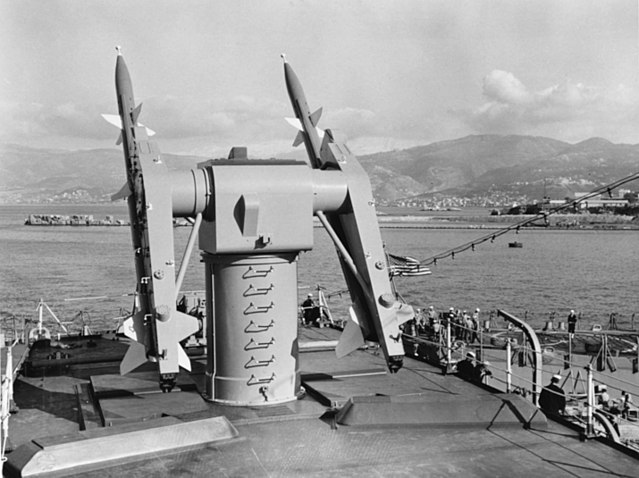
RIM-2 Terrier onboard USS Boston in 1966
The RIM-2 Terrier concept was initially close to the Talos, but diverged as development went on, focusing on smaller targets, closer. Talos evolved to shot down Soviet bombers armed with antiship missiles, while Terrier would eliminate the antiship missiles themselves after launch. The type of warhead needed changed, to a trusted blast-fragmentation system. Its development started with a wing-controlled and beam-riding missile capable of 1.8 Mach over 10 nautical miles. At the end of the process, it was tail-controlled, with semi-active radar homing and capable of mach 3.0 over 40 nautical miles and a 80,000 feet ceiling. It became so successful it became the standard on all USN ships, on destroyers and cruisers, and 8,000 were built in all, deployed on twin launchers, quick reload with often 80 vectors in stock inside the hull. It was replaced by the RIM-67 Standard Missile in the 1980s but equipped the Albany, California and Virginia-class cruisers as well as the Charles F. Adams, Mitscher, Forrest Sherman and Kidd-class destroyers and Brooke class frigates.
RIM-24 TARTAR
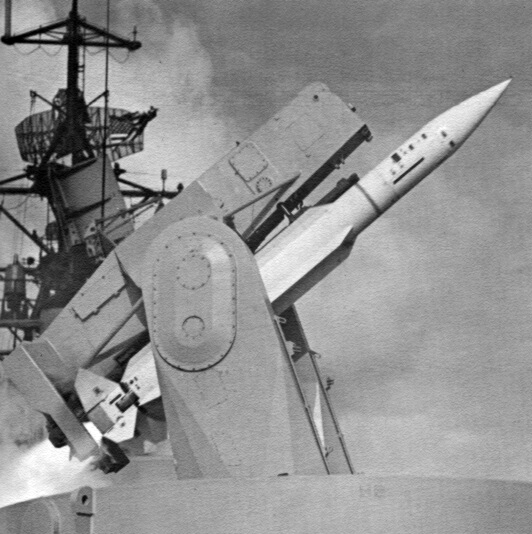
The small, short range Tartar was deployed on three cruisers classes, USN destroyers and frigates, but also Dutch, French, German, Italian, Japanese and Australian destroyers.
The RIM-24 Tartar was the small, short, to very close range vector in the family, and could be deployed against all sorts of missiles. It was used not only by destroyers, but also Frigates and came with a simpler and lighter single Mk.13/22 launcher, after the initial Mk 11 twin-arm launcher. It was capable of Mach 1.8, with a 18 miles range and ceiling of 65,000 feet. The ambition was to replace all twin 5-inch/38 in service in the USN by these launchers on destroyers. However the program had lower priority so at some point in June 1955, CNO Admiral Arleigh Burke pressed the case and urged development. It became basically a RIM-2C Terrier without the secondary booster, to ease production and was otherwise known as the Mk 15.
In the end, the legacy of three Ts and operational capabilities were not only to focus the U.S. Navy attention of a standard system, providing stability, but also revealed limits on improving constantly the missiles themselves, and the Navy came to recognize that further advances would necessarily involved the technical environment surrounding the missile, like the fire-control systems, computing, radars and target management as a whole. It became more logical to focus on the overall performance and this was the impulse and inspiration for the future Aegis system.
RIM-50 Typhoon
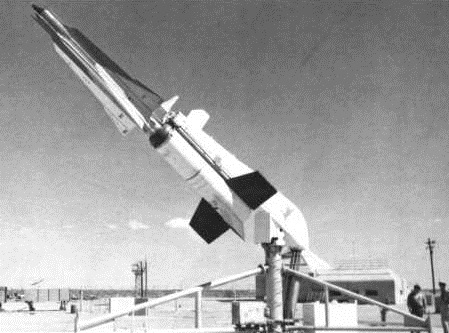
The RIM-50 Typhon was an alternative “universal” SAM missile project developed in the late 1950s. The SAM-N-8 Typhon LR (RIM-50A), SAM-N-9 Typhon MR -(RIM-55A) by Bendix Corp. were paired with the AN/SPG-59 radar system. These were tested on the USS USS Norton Sound from 1962 but around 1966 the program was terminated. It was a superb example of faster, higher “super-Talos” which cost was deemed too high, and replaced by the better all-round standard system, wich started to focus on the missile environment instead.
SM-1 STANDARD
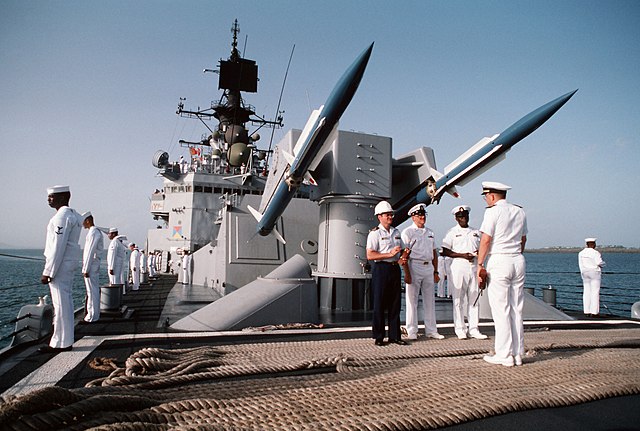
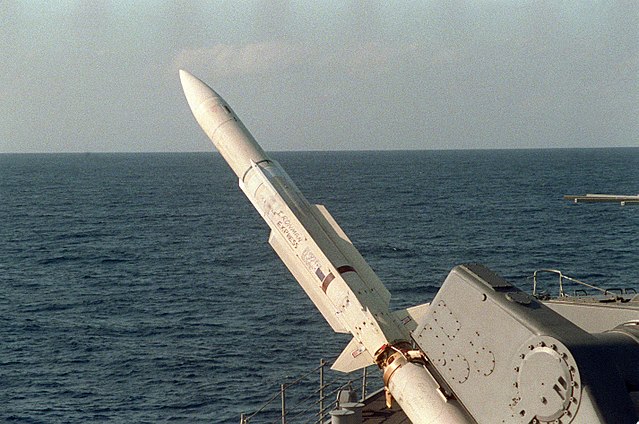
![]()
The standard, was the original idea of a universal missile that could be tailored with some modularity for various tasks. The first model became operational in 1968. It replaced the Tartar, using the same launcher and Fire Control System. First combat was in the early 1970s, Vietnam war. By the late 1970s the second model development started, and it became operational with the Aegis Combat System in 1983 (so with the Ticonderoga class cruisers). Standard 1 and 2 were in effect SAM/SSM and first combat use was during Operation Praying Mantis, 3 July 1988. USS Vincennes (CG-49) shot down by error an Iran Air Flight 655 with two SM-2MR missiles.
RUR-5 ASROC
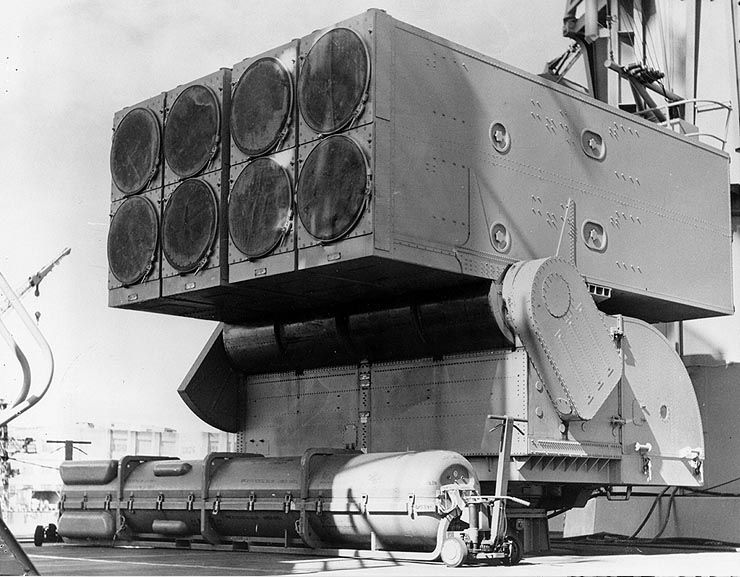
The characteristic RUR-5 “Matchbox” launcher of the 1960s.
Officially called RUR 5, Anti-Submarine ROCket, the famous acronym became the proverbial ASW weapon of choice during the cold war. It was not only used by the USN but a large variery of navies from major nations but France and UK. Although the concept was still inherited from the Hedgehog, rockets were replaced by missiles at the end of the program. It started with the RAT or Rocket Assisted Torpedo program by the Naval Ordnance Test Station at China Lake in the 1950s. The idea was to launch at great distances a torpedo delivered by parachute from the air, giving little notice to the attacked submarines, reached underwater in seconds.
The program ended with a derivative of the RAT-C, which became operational in 1960 on USN destroyer USS Norfolk. The system called for a distinctively orientable MK-112 “Matchbox” launcher, which lasted for 30 years and became a familiar feature of all USN ships of the Frigate size and above; It was replaced in 1990 by vertical launchers RUM-139/VLA. When the position was located, a rocket propelled an offensive payload which could be an acoustic homing torpedo or even a W44 Nuclear Depth Bomb. The Mark 46 torpedo carried a 96.8 pounds (43.9 kg) PBXN-103 HE payload. The use of a parachute allowed entering water at low speed, with minimum detectable noise.
The W44 lacked precision but of course the blast was a 100% kill even at a distance. Depending on the model, torpedoes were self-guided using an active or passive sonar. The W44 was a 10 kt model, retired in 1989 of all ships when the Nuclear Test Ban Treaty was signed. The Soviet navy also made use of small nuclear depht charges, sometimes dropped by helicopters.
⚙ ASROC specifications |
|
| Design Year and introduction | 1955 Naval Ordnance Test Station Pasadena |
| Manufacturer | Honeywell |
| Cost (without payload) | Approximately $350,000 |
| Weight | 1,073 pounds (487 kg) |
| Dimensions | Length 14.75 ft (4.50 m), Diameter 16.6 inches (420 mm), Wingspan 26+7⁄8 inches (680 mm) |
| Propulsion | Solid propellant rocket motor |
| Speed | Subsonic |
| Range | 6 mi (9.7 km) |
| Payload | Mark 46 torpedo, 96.8 Ibs PBXN-103 high explosive or 10 kt W44 nuclear warhead |
| Associated Sensor | |
| Operators | |
Soviet Missiles
The Japanese ‘human missile”, Yokosuka “Baka”
(Work in progress !)
Cold War Antiship Missiles
Cold War Surface to Air Missiles
Cold War ASW Missiles
Submarine-launched Missiles
Airborne antiship Missiles
(Work in progress !)
Airborne AA Missiles
 AIM-9 Sidewinder (1975)
AIM-9 Sidewinder (1975)
The standard cold war HS AA missile:
By all means, the AIM-9 Sidewinder was a huge success story in the history of missile development. Not only it became the premier AAM (Air to Air Missile), replacing guns as a primary weapon on planes in the US NAVY (where it started), but was adopted by the USAF and soon NATO and friendly countries. Soon copied by Soviet engineers it became also the premier AAM of the Soviet bloc and nearly all aviations around the world that could afford modern missile-armed jets. This post as for object the study of this amazing missile, from the very roots of its developments, the personal involved and locations, its variants and active deployments, and still used to this day in more than 45 countries.
Early developments
The ‘China Lake gang’
Video
An amazing documentary by Technical Information Division NAVAIR Weapons Division, China Lake, 2002

 Latest Facebook Entry -
Latest Facebook Entry -  X(Tweeter) Naval Encyclopedia's deck archive
X(Tweeter) Naval Encyclopedia's deck archive Instagram (@navalencyc)
Instagram (@navalencyc)





 French Navy
French Navy Royal Navy
Royal Navy Russian Navy
Russian Navy Armada Espanola
Armada Espanola Austrian Navy
Austrian Navy K.u.K. Kriegsmarine
K.u.K. Kriegsmarine Dansk Marine
Dansk Marine Nautiko Hellenon
Nautiko Hellenon Koninklije Marine 1870
Koninklije Marine 1870 Marinha do Brasil
Marinha do Brasil Osmanlı Donanması
Osmanlı Donanması Marina Do Peru
Marina Do Peru Marinha do Portugal
Marinha do Portugal Regia Marina 1870
Regia Marina 1870 Nihhon Kaigun 1870
Nihhon Kaigun 1870 Preußische Marine 1870
Preußische Marine 1870 Russkiy Flot 1870
Russkiy Flot 1870 Svenska marinen
Svenska marinen Søværnet
Søværnet Union Navy
Union Navy Confederate Navy
Confederate Navy Armada de Argentina
Armada de Argentina Imperial Chinese Navy
Imperial Chinese Navy Marinha do Portugal
Marinha do Portugal Mexico
Mexico Kaiserliche Marine
Kaiserliche Marine 1898 US Navy
1898 US Navy Sovietskiy Flot
Sovietskiy Flot Royal Canadian Navy
Royal Canadian Navy Royal Australian Navy
Royal Australian Navy RNZN Fleet
RNZN Fleet Chinese Navy 1937
Chinese Navy 1937 Kriegsmarine
Kriegsmarine Chilean Navy
Chilean Navy Danish Navy
Danish Navy Finnish Navy
Finnish Navy Hellenic Navy
Hellenic Navy Polish Navy
Polish Navy Romanian Navy
Romanian Navy Turkish Navy
Turkish Navy Royal Yugoslav Navy
Royal Yugoslav Navy Royal Thai Navy
Royal Thai Navy Minor Navies
Minor Navies Albania
Albania Austria
Austria Belgium
Belgium Columbia
Columbia Costa Rica
Costa Rica Cuba
Cuba Czechoslovakia
Czechoslovakia Dominican Republic
Dominican Republic Haiti
Haiti Hungary
Hungary Honduras
Honduras Estonia
Estonia Iceland
Iceland Eire
Eire Equador
Equador Iran
Iran Iraq
Iraq Latvia
Latvia Liberia
Liberia Lithuania
Lithuania Mandchukuo
Mandchukuo Morocco
Morocco Nicaragua
Nicaragua Persia
Persia San Salvador
San Salvador Sarawak
Sarawak Uruguay
Uruguay Venezuela
Venezuela Zanzibar
Zanzibar Warsaw Pact Navies
Warsaw Pact Navies Bulgaria
Bulgaria Hungary
Hungary

 Bundesmarine
Bundesmarine Dutch Navy
Dutch Navy Hellenic Navy
Hellenic Navy Marina Militare
Marina Militare Yugoslav Navy
Yugoslav Navy Chinese Navy
Chinese Navy Indian Navy
Indian Navy Indonesian Navy
Indonesian Navy JMSDF
JMSDF North Korean Navy
North Korean Navy Pakistani Navy
Pakistani Navy Philippines Navy
Philippines Navy ROKN
ROKN Rep. of Singapore Navy
Rep. of Singapore Navy Taiwanese Navy
Taiwanese Navy IDF Navy
IDF Navy Saudi Navy
Saudi Navy Royal New Zealand Navy
Royal New Zealand Navy Egyptian Navy
Egyptian Navy South African Navy
South African Navy






























 Ukrainian Navy
Ukrainian Navy dbodesign
dbodesign